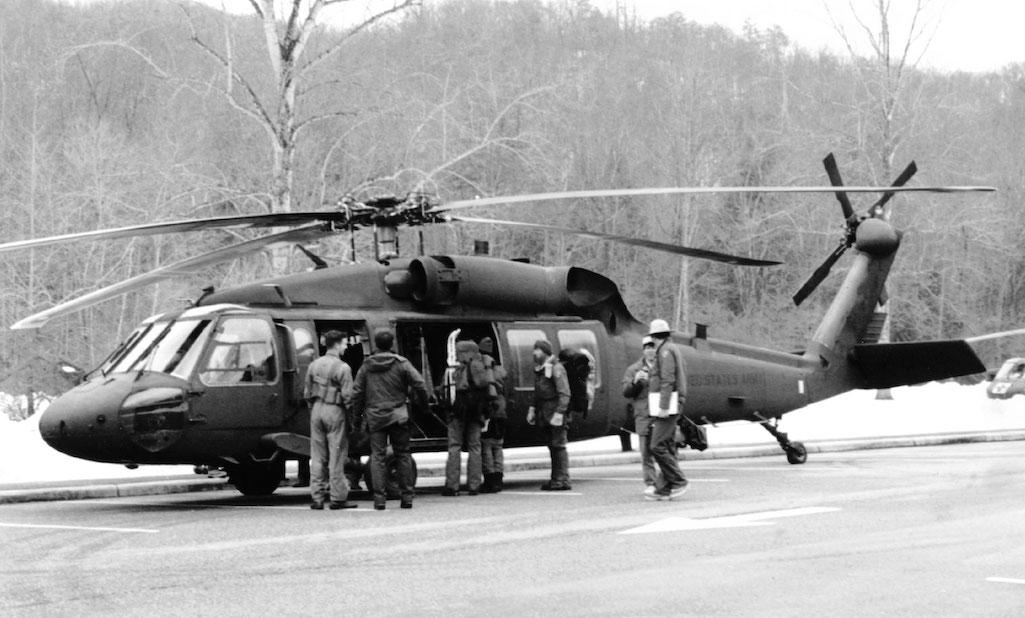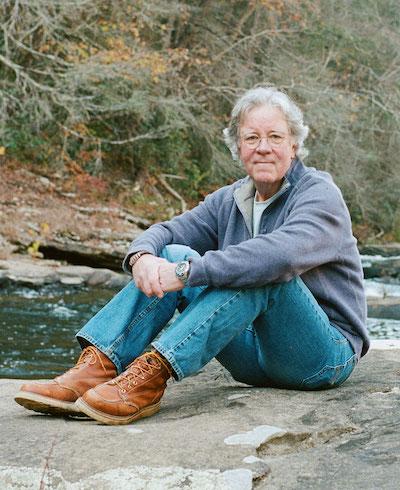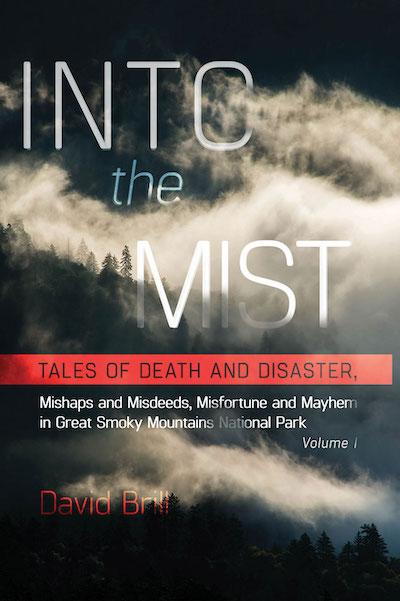
Around half of the stories in Into the Mist are about heroic rescues, which helps builds confidence in the park’s law enforcement staff and the rangers/NPS archives.
Appalachian Trail Inspired Thru-Hiker to Become a Journalist
By Walt Evans
“We don’t go to national parks strictly to identify plant and animal species. We enter the parks because we seek a visceral experience of being immersed in that wild environment.” ~David Brill
David Brill is one of the Smokies’ great living storytellers. He is a writer in the outdoor–adventure field, but his work doesn’t shy away from the contemplative, the quiet moments when wild places arouse in us feelings of solitude, solace, communion, and awe. Upwards of 20 of his articles have been published in the journal Smokies Life—everything from a deep dive into black bear research to a harrowing rescue on the Old Settler’s Trail to a day in the life of a search-and-rescue ranger.
Brill’s career as a chronicler of America’s public lands stretches back to 1979 when, at the age of 23, he hiked the Appalachian Trail from Georgia to Maine, an experience detailed in his first book, the essay collection As Far as the Eye Can See, published in 1990. Now in its fifth edition, eighth printing (University of Tennessee Press, 2020), the book has since become a classic of AT literature; Brill’s anecdotes and lessons learned remain as useful as they are inspiring to generations of actual as well as would-be thru-hikers.
Several decades into his writing career, Brill continues to produce enlightening work about humanity’s relationship with nature from his remote cabin near the Obed Wild and Scenic River. In 2017, Great Smoky Mountains Association published Into the Mist vol. 1, a compendium of disasters, fatalities, and heroic rescues that have occurred in Great Smoky Mountains National Park since 1931. Despite the book’s often-chilling subject matter, Brill’s dramatic renderings of 13 true stories are at once compassionate and thrilling. A valuable record of the awesome and often deadly natural forces that shape the Smokies, the title also serves as an educational safety manual to help future park visitors avoid potentially dangerous situations.
I sat down with David near his home on Tennessee’s Cumberland Plateau to discuss how he built a career as a nature writer, his best-known books, and what continues to fascinate him about America’s most-visited national park.
Walt Evans: How did you get started writing? Who were your influences?
David Brill: When I was an undergraduate at Indiana University, I studied modern American literature—Hemingway, Fitzgerald, Steinbeck. My pipe dream was to be a novelist. But I dismissed that as being impossible; that was never going to happen.
WE: Why did you think it was impossible?
DB: I didn’t think my work measured up to that of my heroes. But I’d been planning to hike the Appalachian Trail, so in 1979 I set out. As Thoreau puts it, “Only that day dawns to which we are awake.” I totally woke up. Every day was this wild awakening. New territory, new terrain, new people. So, when I reached the end of the trail, I knew what I wanted to do. I wanted to be, not a fiction writer, but a journalist, because I had this story in me that I was burning to tell. In the context of a lifetime, five and a half months is not that long, but it completely transformed me.
WE: What was it like to take your AT experience and shape it into your first book?
DB: For ten years I carried that experience around with me through different editing and writing jobs. It wasn’t until a magazine called Tennessee Illustrated wanted me to go out and hike seven days in the Smokies along the Appalachian Trail that I found a way to shoehorn it in. A photographer and I went out, and we hiked. And when I sat down and started writing that essay, the larger story just tumbled out of me. I got to 20 pages, and I realized I had quadrupled the assignment. It was a cathartic outpouring of all these memories. But it was cogent, it was organized.
I submitted it, and the editor called me the next day and said, “I have some good news and some bad news.” The bad news: “This is all over the place. It’s about the whole Appalachian Trail. I’m gonna have to kill this story or you’re gonna have to rewrite it.” So, I asked, “What’s the good news?” He said, “You have a book in you.” Soon after, he proffered an introduction to a regional publisher. Over the next eight months, I crafted As Far as the Eye Can See and shipped it off to Rutledge Hill Press.
WE: Since As Far as the Eye Can See, your work has continued to evolve, especially with your latest book, Into the Mist: Tales of Death, Disaster, Misdeeds Misfortune, and Mayhem in Great Smoky Mountains National Park. How did that one come about?
DB: Well, Into the Mist was commissioned. The editor of Smokies Life journal asked me to come up with a concept for that book.
Once I began writing about tragic fatalities and major weather events in Great Smoky Mountains National Park, I was riveted by the incidents. Through the Freedom of Information Act, I was able to acquire the redacted incident reports for what would become the book’s 13 narrative chapters. And the park service staffers, the rangers and law enforcement personnel, gave me all the additional information I needed. The raw material was already there in the detailed incident reports, and they provided a natural narrative structure. When I set out to write the first chapter about John Mink, who died of hypothermia on the Miry Ridge Trail in 1986, the story was there, begging to be told. In crafting the book’s chapters, I felt the same narrative drive I feel when I’m relaying my own outdoor experience: “Where do I start, what facts do I present, how do I hook this reader?”
WE: Into the Mist is a propulsive book; I flew through it. It seems like you have a good handle on how to tell these stories compellingly while remaining empathetic to your subjects. But I have to say, the chapters about crime investigations were especially thrilling.
DB: The rescue stories were particularly engaging to write. With the deadly Derecho of 2012, which claimed two lives and injured dozens of individuals, and the blizzard of March 1993, which stranded 159 people in the park’s backcountry, the Park Service effectively rallied its partners and successfully brought injured and isolated people to safety.
But the chapters that deal with death and crime were much more difficult to craft. I couldn’t turn away from the narratives, but the awareness that these stories were chronicling actual human lives challenged me emotionally. Most of my work has been about people having fun in the outdoors. So, Into the Mist was very different, but I loved the project. And I’m a bit more cautious out on the trail these days.
WE: In the introduction, you write about how the book “can be instructive, allowing GSMNP managers to assess the relative risks associated with various activities and specific locations within the park and thereby enhance visitor safety and education efforts.” I’m drawn to that idea of writing as a service, offering something that people can use.
DB: I would say that many, if not most, of the deaths chronicled in Into the Mist could’ve been prevented. If you don’t go in the water, you won’t drown. If you go out on a winter excursion, you should expect that you might hike into the teeth of a blizzard. Do you have shelter? Do you have a warm sleeping bag and multiple thermal layers? Do you have extra rations of food?
It’s interesting; when I’ve done book signings, there have been a few prospective readers who think I’m exploiting the suffering of people to turn a profit. That was not my intention at all. Many other readers, however, have kindly acknowledged how sensitively the subjects were treated. I really tried to bear in mind through the writing process that these are human beings, not just words on a page.
Throughout the writing of Into the Mist, I had the notion that these are tales that can heighten awareness of risk and showcase the extraordinary efforts of the park’s ranger staff to keep visitors safe. As for the latter, the story of John Peck, the fugitive who’d allegedly gunned down his girlfriend and headed to the park, is a case in point. That chapter depicts the efficiency and valor of the law-enforcement rangers in confronting an alleged killer and protecting visitors from harm. It builds confidence in the park’s rangers, exquisitely capable people who are devoted to safeguarding you and the millions of others who visit the park each year.
Walt Evans is a writer based in Knoxville, Tennessee. He holds an MFA in creative writing from the University of Tennessee and is currently at work on his first novel. A longer version of this story appeared as a two-part series in the Smokies LIVE blog produced by Great Smoky Mountains Association. This version has been edited by Frances Figart for the National Parks Traveler audience.




